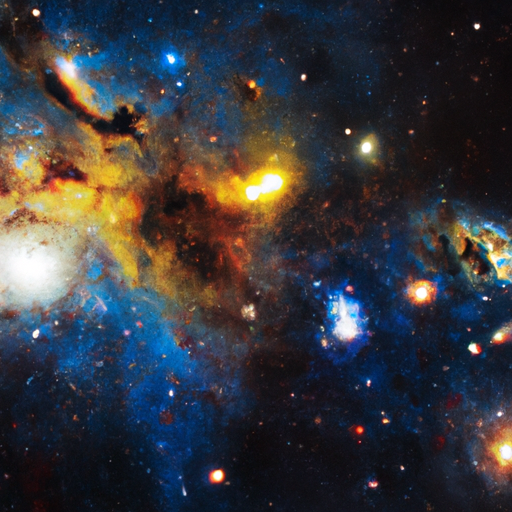In this captivating article, you will embark on a journey to unravel the mystery surrounding dark matter and dark energy. These enigmatic entities have puzzled scientists for decades, with their elusive nature and profound influence on the universe. Get ready to discover the latest theories and research that shed light on these invisible forces, as we delve into the depths of the cosmos and explore the captivating world of dark matter and dark energy.
The Basics of Dark Matter
Definition and Significance
Dark matter is a mysterious form of matter that is believed to make up a substantial portion of the universe, yet eludes direct detection. Unlike ordinary matter, which is composed of protons, neutrons, and electrons, dark matter does not interact with electromagnetic radiation, making it difficult to observe. Its significance lies in the fact that it plays a crucial role in the formation and evolution of galaxies and large-scale structures in the universe.
Observations of Dark Matter
Although dark matter cannot be directly observed, its presence can be inferred through its gravitational effects on visible matter. For instance, the rotation curves of galaxies indicate that there is more mass present than what is accounted for by visible matter. Additionally, the gravitational lensing of light from distant galaxies is another observation that supports the existence of dark matter. These observations have provided strong evidence for the existence of dark matter, sparking further curiosity about its nature and properties.
The Puzzle of Dark Matter
The puzzle of dark matter lies in its elusive nature and the mystery surrounding its composition. Despite decades of research, scientists have yet to identify the fundamental particles that make up dark matter. This has led to the formulation of various theoretical models and candidates, which will be explored further in subsequent sections. Solving the puzzle of dark matter is crucial for a complete understanding of the universe and its evolution.
The Search for Dark Matter
Scientists are diligently seeking ways to detect and study dark matter, employing various experimental and observational methods. These efforts include direct detection experiments, indirect detection methods, and the use of particle colliders. Direct detection experiments aim to capture interactions between dark matter particles and ordinary matter, while indirect detection methods involve searching for the products of dark matter annihilation or decay. Particle colliders, such as the Large Hadron Collider (LHC), aim to produce and study dark matter particles by recreating the conditions of the early universe. The search for dark matter continues to be an active area of research, with the hope of unraveling the mystery it presents.
The Nature of Dark Matter
Possible Candidates for Dark Matter
Scientists have proposed several candidates for dark matter, each with its own unique properties and implications. One prominent candidate is the Weakly Interacting Massive Particle (WIMP), which is a hypothetical particle that interacts weakly with ordinary matter through the weak nuclear force. Other possible candidates include axions, sterile neutrinos, and primordial black holes. It is important to note that none of these candidates have been conclusively proven to be the elusive dark matter particles, but they offer tantalizing possibilities for further investigation.
WIMP and Axions
WIMPs and axions are two extensively studied candidates for dark matter. WIMPs, as their name suggests, are massive particles that interact weakly with ordinary matter. They were proposed to explain the observed dark matter abundance in the universe. Axions, on the other hand, were initially suggested to resolve a discrepancy in the equations of the strong nuclear force but have also been considered as potential constituents of dark matter. Both WIMPs and axions are actively researched and subject to ongoing experimental searches.
Supersymmetry and Dark Matter
Supersymmetry is a theoretical framework that proposes a connection between fundamental particles and their superpartner particles. This symmetry could provide a natural explanation for the existence of dark matter in the universe. Within the framework of supersymmetry, the lightest supersymmetric particle (LSP) is a prime candidate for dark matter. If supersymmetry is realized in nature, it would have far-reaching implications not only for dark matter but also for our understanding of particle physics.
Constraints on Dark Matter Models
Despite the multitude of potential dark matter candidates, experimental and observational results have placed constraints on their properties. For example, certain models of dark matter predict interactions with ordinary matter that have not been observed in direct detection experiments. These constraints serve as valuable guidance for refining theories and narrowing down the search for dark matter particles.

Detecting Dark Matter
Direct Detection Experiments
Direct detection experiments aim to capture the rare interactions between dark matter particles and ordinary matter. These experiments typically rely on sensitive detectors placed deep underground to shield against cosmic rays and other background radiation. When a dark matter particle collides with atomic nuclei, it may produce tiny signals that can be detected and analyzed. However, to date, no definitive signal of dark matter has been observed in these experiments, leading scientists to continually improve and refine their techniques.
Indirect Detection Methods
Indirect detection methods involve searching for the secondary products of dark matter annihilation or decay. When two dark matter particles collide, they can produce high-energy particles such as photons, neutrinos, or cosmic rays. By detecting these energetic particles, scientists can infer the presence of dark matter. Observatories and detectors, such as the Fermi Gamma-ray Space Telescope and the IceCube Neutrino Observatory, are actively searching for such signals from regions of high dark matter density, such as the center of our galaxy.
The Role of Particle Colliders
Particle colliders, such as the LHC, provide another avenue for detecting dark matter. By smashing particles together at extremely high energies, scientists can create conditions that mimic the early universe, where dark matter particles were likely abundant. These collisions may yield new particles, including potential dark matter candidates, which can be detected and studied. Particle colliders play a crucial role in the ongoing search for dark matter and offer insights into its properties and interactions with ordinary matter.
Future Prospects for Detection
As technology and experimental techniques continue to advance, the prospects for detecting dark matter are becoming increasingly promising. Next-generation direct detection experiments, such as the LUX-ZEPLIN and XENONnT experiments, are expected to improve sensitivity and increase the chances of capturing a dark matter signal. Indirect detection methods are also being refined and expanded, with upcoming observatories like the Cherenkov Telescope Array and the Euclid mission poised to make significant contributions. Continued research and exploration hold the key to detecting and unraveling the mysteries of dark matter.
Exploring the Dark Energy Phenomenon
Defining Dark Energy
Dark energy is a hypothetical form of energy that permeates all of space and is believed to be responsible for the accelerated expansion of the universe. Unlike dark matter, dark energy does not clump together, but instead, it is uniformly distributed throughout the cosmos. Its exact nature remains a mystery, but its presence is inferred from the observational data.
The Discovery of Dark Energy
The discovery of dark energy was a groundbreaking revelation that came from observing the brightness of distant supernovae. Astronomers expected that the expansion of the universe would be slowing down due to the gravitational pull of matter. However, they found that the expansion was accelerating, indicating the presence of an unknown force counteracting gravity. This force was later referred to as dark energy.
The Nature of Dark Energy
The nature of dark energy remains one of the most perplexing questions in cosmology. It is often associated with the cosmological constant, a term originally introduced by Albert Einstein to balance out the attractive nature of gravity. However, the cosmological constant alone cannot fully account for the observed properties of dark energy. Other explanations, such as scalar fields or modifications to the theory of gravity, are also being explored.
The Equation of State Parameter
The equation of state parameter is a measure of the pressure exerted by dark energy compared to its energy density. It helps determine the nature of dark energy and its influence on the expansion of the universe. Currently, the equation of state parameter for dark energy is believed to be close to -1, indicating that its pressure is negative, driving the accelerated expansion of the universe. Further studies and observations are needed to precisely determine the equation of state parameter and gain insights into the nature of dark energy.

The Expansion of the Universe
The Hubble Constant
The Hubble Constant, named after astronomer Edwin Hubble, quantifies the rate at which the universe is expanding. It relates the distance to a galaxy (or any celestial object) to its recession velocity. Measuring the Hubble Constant is crucial for understanding the dynamics of the universe. However, different methods of measurement have yielded slightly different values, leading to an ongoing debate about its precise value.
The Big Bang Theory
The Big Bang theory is the prevailing cosmological model that describes the origin and evolution of the universe. According to this theory, the universe began as an extremely hot and dense singularity, approximately 13.8 billion years ago. It has been expanding ever since, eventually cooling down and allowing matter and energy to form. The Big Bang theory provides the framework for understanding the expansion of the universe and the behavior of dark energy.
The Cosmic Microwave Background
The cosmic microwave background (CMB) is the faint radiation left over from the Big Bang. It permeates the entire universe and provides crucial information about its early stages. By studying the CMB, scientists have gained insights into the composition, geometry, and overall evolution of the universe. Precise measurements of the CMB have also helped determine the abundance of dark matter and dark energy in the cosmos.
Measuring the Expansion Rate
Measuring the expansion rate of the universe is a complex task that involves various observational techniques. One common method is to use the redshift of distant galaxies, which is a shift in the wavelength of their light due to the stretching of space. By analyzing the redshift, scientists can determine the recession velocity and, consequently, the expansion rate. Other methods, such as using supernovae as distance indicators or studying the clustering of galaxies, also contribute to our understanding of the expansion rate.
Theories and Explanations
The Cosmological Constant
The cosmological constant, often denoted by the Greek letter lambda (Λ), is a term added to Einstein’s field equations of general relativity. It represents a form of energy density that remains constant over time and is responsible for the repulsive force associated with dark energy. The cosmological constant provides a simple explanation for the accelerated expansion of the universe but raises questions about its origin and value.
Modified Gravity
Modified gravity theories propose modifications to Einstein’s theory of general relativity in order to explain the observed accelerated expansion of the universe without the need for dark energy. These theories posit that gravity behaves differently on cosmological scales, leading to the accelerated expansion. However, reconciling modified gravity with existing observational data remains a challenge, and further research is needed to fully understand its implications.
Quantum Vacuum Energy
Quantum vacuum energy, also known as zero-point energy, refers to the energy inherent in the fabric of space itself. According to quantum field theory, even empty space is not truly empty but filled with fluctuations and virtual particles that contribute to the energy density. It has been suggested that the quantum vacuum energy contributes to the observed dark energy. However, the precise nature of this energy and its role in the expansion of the universe are still subject to ongoing research and debate.
Multiverse Theories
Multiverse theories propose the existence of multiple universes, each with its own set of physical laws and properties. In some variants of these theories, the presence of different universes could explain the observed properties of dark matter and dark energy in our universe. These theories involve complex mathematical frameworks and are highly speculative. While intriguing, they currently lack direct observational evidence and remain highly speculative.

Dark Matter and Dark Energy Interactions
Possible Connections
The interactions between dark matter and dark energy remain an open question in cosmology. While they are distinct phenomena, their coexistence suggests a potential connection. The nature of this connection, if it exists, could provide valuable insights into the fundamental properties of both dark matter and dark energy. Various theoretical models and hypotheses have been proposed to explain the potential interactions, but experimental evidence is still needed to confirm or reject these ideas.
The Impact on the Cosmos
Dark matter and dark energy play crucial roles in shaping the structure and evolution of the cosmos. Dark matter’s gravitational effects create the scaffolding for the formation of galaxies and galaxy clusters, while dark energy drives the accelerated expansion of the universe. The interplay between these two phenomena influences the large-scale structure of the universe, determining the distribution of matter and the growth of cosmic structures over time.
Exploring the Cosmic Web
The cosmic web refers to the intricate network of filaments, clusters, and voids that make up the large-scale structure of the universe. Dark matter serves as the underlying framework upon which the cosmic web is built. By studying the distribution of dark matter through gravitational lensing and other observational techniques, scientists gain insights into the structure and evolution of the cosmic web. Understanding the cosmic web is paramount for unraveling the mysteries of dark matter and dark energy.
Cosmic Structure Formation
The intricate process of cosmic structure formation is driven by the gravitational interactions of dark matter. Dark matter’s gravitational pull attracts ordinary matter, leading to the formation of galaxies, galaxy clusters, and other cosmic structures. Simulations that incorporate the properties of dark matter are essential for understanding this complex process and comparing the results with observational data. By studying the formation and evolution of cosmic structures, scientists can gather valuable clues about the properties and behavior of dark matter and dark energy.
Galactic Dynamics and Dark Matter
The Role of Dark Matter in Galaxy Formation
Dark matter plays a crucial role in the formation and evolution of galaxies. It provides the gravitational pull necessary to counterbalance the outward forces and maintain the cohesion of galaxies. The distribution of dark matter determines the distribution of visible matter, shaping the overall structure of galaxies. The detailed dynamics of dark matter within galaxies, such as rotation curves and halo profiles, provide valuable insights into its properties and distribution.
Rotation Curves of Galaxies
Rotation curves describe the distribution of mass within galaxies as a function of distance from the center. Observations of rotation curves have provided strong evidence for the presence of dark matter. Unlike the expected decline in rotational velocity with increasing distance from the galactic center, rotation curves often exhibit flat or slowly rising profiles. These observations indicate the presence of additional mass, presumably in the form of dark matter, beyond what is accounted for by visible matter.
Dynamics of Galaxy Clusters
Galaxy clusters are the largest gravitationally bound structures in the universe, consisting of numerous galaxies embedded in a halo of dark matter. The dynamics of galaxy clusters, including their mass distribution and velocity dispersion, offer valuable insights into the properties of dark matter. Measurements of galaxy cluster dynamics, in conjunction with statistical analyses and simulations, help constrain dark matter models and provide a deeper understanding of its nature and behavior.
Simulations and Dark Matter
Computer simulations play a crucial role in studying the behavior of dark matter. By inputting initial conditions and simulating the gravitational interactions of dark matter particles, scientists can recreate the observed large-scale structures of the universe. Simulations also allow for the exploration of different dark matter models, testing their predictions against observational data. The combination of simulations and observations helps refine our understanding of dark matter and its role in the cosmos.

The Role of Dark Energy in the Universe
The Fate of the Universe
The presence of dark energy has profound implications for the future of the universe. Its repulsive nature causes the expansion of the universe to accelerate, leading to a potential “Big Freeze” scenario. In this scenario, the universe continues to expand indefinitely, distancing galaxies from each other and eventually causing stars to die out. Understanding the dynamics of dark energy is crucial for determining the fate of the universe and our place within it.
Effects on Large-Scale Structure
Dark energy influences the large-scale structure of the universe by driving the accelerated expansion. As the expansion continues, the gravitational pull of dark matter becomes weaker compared to the repulsive force of dark energy. This interplay affects the formation and growth of cosmic structures, shaping the distribution of galaxies and galaxy clusters over cosmological timescales. Investigating the effects of dark energy on large-scale structure provides valuable insights into its nature and the evolution of the cosmos.
Dark Energy and Supernovae
Supernovae, particularly Type Ia supernovae, have played a crucial role in measuring the expansion rate of the universe and providing evidence for dark energy. The precise brightness of Type Ia supernovae allows scientists to infer their distance, and the observed redshift provides information about their recession velocity. By comparing the observed brightness and redshift of distant supernovae, scientists discovered the accelerating expansion of the universe and the existence of dark energy.
Gravitational Lensing
Gravitational lensing, the bending of light by the gravitational field of massive objects, offers another avenue for studying the effects of dark energy. By measuring the distortion of light from distant galaxies, scientists can map the distribution of matter and infer the presence of dark energy. Gravitational lensing provides a unique probe of the cosmic web and allows for precise measurements of the growth of large-scale structures. It serves as a valuable tool for studying the influence of dark energy on the universe.
Unanswered Questions and Future Directions
The Nature of Dark Matter and Dark Energy
While much progress has been made in understanding dark matter and dark energy, many questions about their nature remain unanswered. The ultimate identification of dark matter particles and a deeper understanding of the physical origin of dark energy are among the most pressing challenges in modern cosmology. Further research, both theoretical and observational, is needed to shed light on these enigmatic phenomena.
Unresolved Cosmological Issues
Dark matter and dark energy are intimately connected to several unresolved issues in cosmology, such as the cosmic microwave background anomalies, the nature of inflation, and the hierarchy problem in particle physics. Solving these problems may provide insights into the underlying physics that give rise to dark matter and dark energy. Their resolution requires continued research, collaboration, and the development of new theoretical and observational tools.
Current and Future Research Efforts
Scientists around the world are actively engaged in research efforts to understand dark matter and dark energy. Observational missions, such as the upcoming Euclid mission and the NASA-led Nancy Grace Roman Space Telescope, aim to probe the properties of dark matter and dark energy through precise measurements of large-scale structures and cosmic microwave background radiation. Theoretical advancements, including the exploration of modified gravity theories and the development of innovative particle detection techniques, continue to expand our knowledge in these fields.
Potential Breakthroughs
The field of dark matter and dark energy research is ripe for potential breakthroughs. Continued advancements in technology, observational capabilities, and theoretical frameworks may unveil new insights into the fundamental nature of these phenomena. The discovery of dark matter particles, a deeper understanding of dark energy’s origin, or the emergence of new theoretical models could revolutionize our understanding of the universe. The ongoing quest to unravel the mysteries of dark matter and dark energy holds the promise of exciting discoveries yet to come.
In conclusion, delving into the depths of dark matter and dark energy presents a captivating journey of scientific exploration. From their elusive natures to their profound impact on the formation of galaxies and the expansion of the universe, these phenomena continue to challenge our understanding of the cosmos. While many questions remain unanswered, the tireless efforts of researchers worldwide offer hope for unraveling the mysteries of dark matter and dark energy, and ultimately, a more comprehensive understanding of our universe.